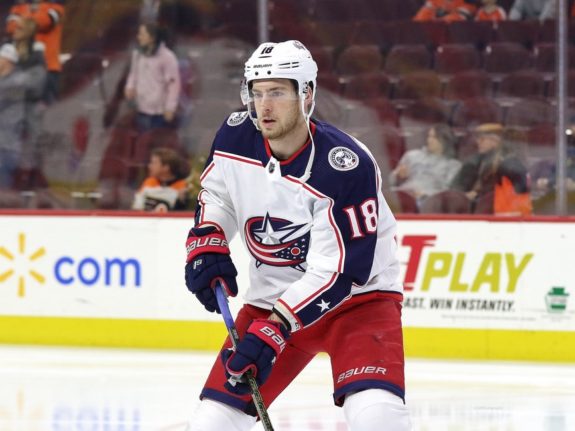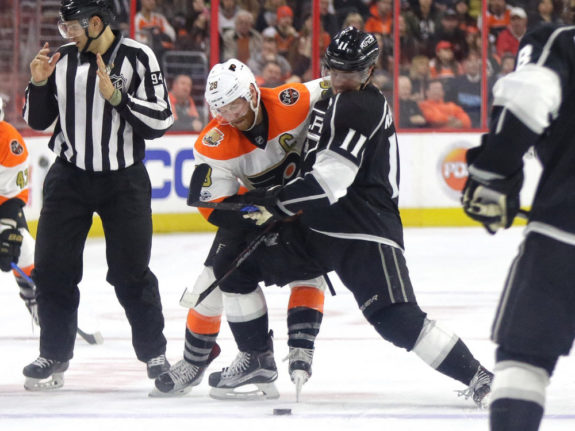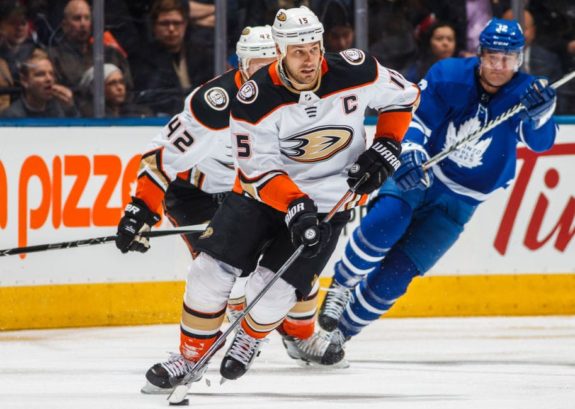Perhaps the most important role in today’s NHL is the first line center. They are tasked with producing points, consistently winning faceoffs and providing solid two-way coverage, all while playing top minutes against the best players in the league. Halfway through his second season with the Columbus Blue Jackets, Pierre-Luc Dubois has handled this role with maturity while still growing with a young Blue Jackets squad.

However, what can the team and fans expect out of Dubois in the future? What kind of player could he grow into as his career moves forward? Is he on track in his career compared to other number one centers at the same point in their careers?
Dubois’ Beginnings
First, let’s look at the first two seasons of Dubois’ NHL career. In the 2017-18 season, Dubois had 20 goals and 28 assists for 48 points. Of those goals, six were on the power play and four were game-winning goals. He was one of only two players to play in all 82 games that season. He finished a plus-eight and won 43.8 percent of faceoffs. For much of the season, he served as the first line center between Artemi Panarin and Josh Anderson.
In the first 39 games of the 2018-19 season, Dubois registered 16 goals and 20 assists for 36 points. He has one power-play goal and three game-winning goals. He is a plus-10 is winning 45.06 percent of draws. Paired with Panarin and Cam Atkinson, Dubois is averaging 18:38 of ice time per game, over a minute more than other Columbus centers.
To pro-rate Dubois’ numbers for this season, let’s assume he produces in the final 41 games at the same pace as the first 39. This equals an approximate 32 goals and 40 assists for 72 points. Now, what about his future? A look at the statistics of the first two seasons of similarly sized first line centers can help us gain some potential insight into the future of the 20-year-old.
Anze Kopitar
Anze Kopitar is regarded as one of the league’s best two-way centers. The recipient of two Selke Trophies, two Stanley Cups and a Lady Byng trophy, Kopitar is an elite level player who thrives in both the offensive and defensive zones. In 2005, he was selected 11th overall by the Los Angeles Kings.

Kopitar’s rookie season of 2006-07 saw the center play in 72 games. He tallied 20 goals and 41 assists for a total of 61 points. He was most active in power play production with seven goals and 22 assists. He also had one game-winning goal and was 46.1 percent in the faceoff circle. This was good enough for him to finish third among rookies in scoring, being bested by Evgeni Malkin and Paul Stastny. He also finished fourth in voting for the Calder Memorial Trophy.
For his sophomore season in 2007-08, Kopitar played in all 82 games and tallied 32 goals and 45 assists for 77 points. The power play was again friendly to him as he netted 12 goals and 22 assists. He netted three game-winners and had a faceoff percentage of 49.22.
Ryan Getzlaf
Ryan Getzlaf was drafted 19th overall in 2003 by the Mighty Ducks of Anaheim. Throughout his career, he has been one of the key play makers for the Anaheim Ducks. In Getzlaf’s rookie campaign in 2005-06, he played in 57 games with 14 goals and 39 points. Like Kopitar, Getzlaf shined on the power play as 10 goals and 24 points came with the man advantage.
His first seven points occurred in his first 16 games. Despite the strong start, Getzlaf was sent to the American Hockey League’s Portland Pirates in mid-November. In mid-January, he was recalled to the NHL.

The 2006-07 campaign was incredibly successful for Getzlaf. Playing in all 82 games, he tallied 25 goals and 58 points. 11 goals and 31 points were on the power play. A key member of the “kid line” with Corey Perry and Dustin Penner, Getzlaf was instrumental in their playoff run. He led the Ducks in postseason scoring with 17 points, a former franchise playoff record. This culminated in the Ducks winning the Stanley Cup, the first in team history.
Dubois’ Future
Dubois’ production thus far in his NHL career is comparable to both Kopitar and Getzlaf in their first two seasons. If we see similar growth in his career as these two, the Blue Jackets can expect big things from their number one center. We can see that strong starts in the first two seasons helped to catapult their careers and made them into two of the most difficult centers to play against.
A case can be made that Dubois is on a similar trajectory. Regardless of the line he is on, Dubois has the ability to both create the play and react to whatever is going on around him.
With his play-making skills and ability to read the play, Dubois is a key player. Granted, Dubois has much to prove before we can truly put him on an equal playing field as these and other players, but he is certainly starting on the right foot.